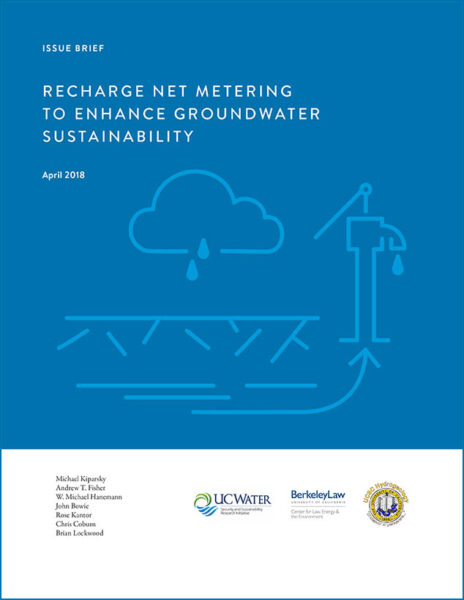
For basins that are critically overdrafted and many others, sustainable management while maintaining current acreage in production means finding a way to replenish their basins. Groundwater recharge is an important component of sustainable groundwater management, as increasing the amount of recharge can help improve conditions in overdrafted basins, or allow for additional pumping in basins that are not experiencing chronic declines in groundwater levels.
Water for groundwater recharge projects can come from many different sources, such as surface water, stormwater runoff, recycled water, or remediated groundwater. Geology permitting, this can then be recharged into the aquifer by way of percolation basins, canals, natural drainages, injection wells, or conjunctive use.
The idea of using groundwater aquifers to manage and store water below ground is certainly not new; programs for managed recharge of groundwater aquifers have been in place for decades in Orange County, Santa Clara Valley, Kern County, and many other regions in the state. It is an important tool for sustainable groundwater management and recovery from groundwater depletion. The ability in wet times to store water underground in dry years is central to the ability to conjunctively manage groundwater and surface water supplies.
Groundwater recharge projects that can also provide multiple benefits, such as maintaining agricultural productivity or domestic water use, sustaining groundwater-dependent ecosystems (GDEs), and providing water for wintering shorebirds and fisheries. Plus, multi-benefit projects can facilitate multiple streams of funding to implement multi-benefit recharge projects.
Key publications
A Technical Framework for Increasing Groundwater Replenishment
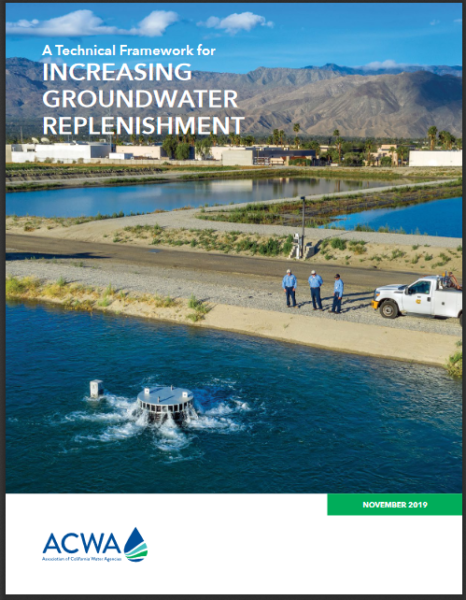 A Technical Framework for Increasing Groundwater Replenishment is a roadmap document for local agencies or groundwater sustainability agencies (GSAs) to utilize when navigating how to develop groundwater replenishment projects.
A Technical Framework for Increasing Groundwater Replenishment is a roadmap document for local agencies or groundwater sustainability agencies (GSAs) to utilize when navigating how to develop groundwater replenishment projects.
This document walks readers through the current landscape of the Sustainable Groundwater Management Act (SGMA) and provides the context that, as part of SGMA implementation, groundwater replenishment will be an important component to how sustainability is achieved under SGMA.
The technical framework provides considerations for how to develop groundwater replenishment projects and includes additional resources that support the development of groundwater replenishment projects, as well as case studies of entities that are piloting their own replenishment projects.
Click here to download A Technical Framework for Increasing Groundwater Replenishment from ACWA.
Replenishing Groundwater in the San Joaquin Valley
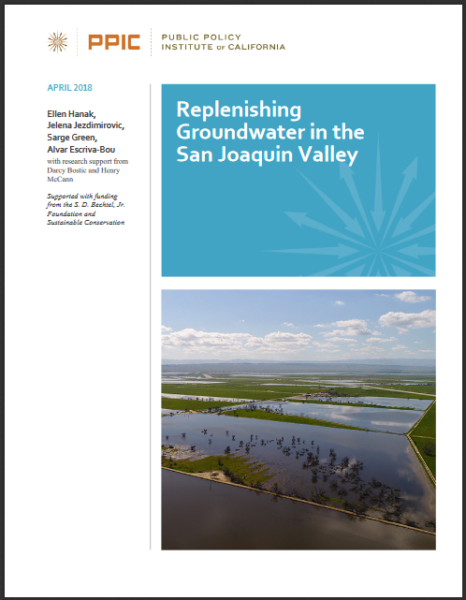 The San Joaquin Valley—which has the biggest imbalance between groundwater pumping and replenishment in the state—is ground zero for implementing the 2014 Sustainable Groundwater Management Act (SGMA). Expanding groundwater recharge could help local water users bring their basins into balance and make a dent in the long-term deficit of nearly 2 million acre-feet per year.
The San Joaquin Valley—which has the biggest imbalance between groundwater pumping and replenishment in the state—is ground zero for implementing the 2014 Sustainable Groundwater Management Act (SGMA). Expanding groundwater recharge could help local water users bring their basins into balance and make a dent in the long-term deficit of nearly 2 million acre-feet per year.
The experience with recharge in 2017―the first wet year since the enactment of SGMA―offers valuable insights in how to expand recharge. A survey of valley water districts’ current recharge efforts revealed strong interest in the practice, and a number of constraints.
Click here to download this report from the Public Policy Institute of California.
Managed Aquifer Recharge and the U.S. Army Corps of Engineers: Water Security through Resilience
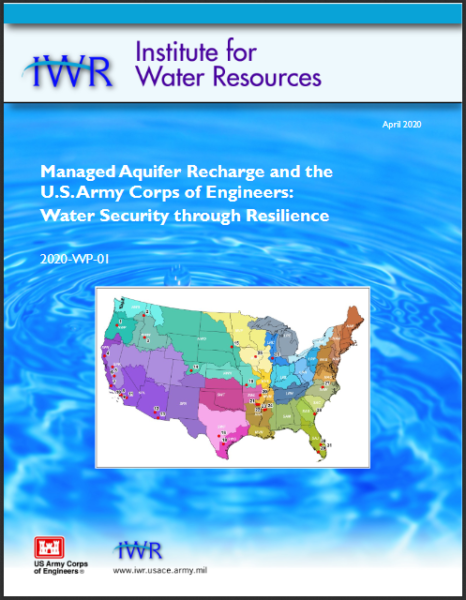 Storing water underground (managed aquifer recharge, or MAR) can augment surface storage and increase resilience of USACE projects and improve our nation’s water security. USACE and its partners are using, have considered or are considering using MAR, or conjunctive management of ground- and surface water, in at least 17 states in six of the seven USACE divisions in the Continental United States.
Storing water underground (managed aquifer recharge, or MAR) can augment surface storage and increase resilience of USACE projects and improve our nation’s water security. USACE and its partners are using, have considered or are considering using MAR, or conjunctive management of ground- and surface water, in at least 17 states in six of the seven USACE divisions in the Continental United States.
The authorities for using MAR in USACE projects are modest but increasing.USACE is using or considering MAR to help fulfill its primary missions of flood risk management and aquatic ecosystem restoration, and for secondary purposes such as drought resilience, water supply, and reducing saltwater intrusion. For secondary mission areas, the agency’s role in MAR is typically to support its partners’ efforts to meet their water resources needs.
MAR can be smoothly integrated into USACE’s planning process, including stakeholder engagement, reallocation studies and forecast-informed reservoir operations.
Building multi-benefit recharge basins
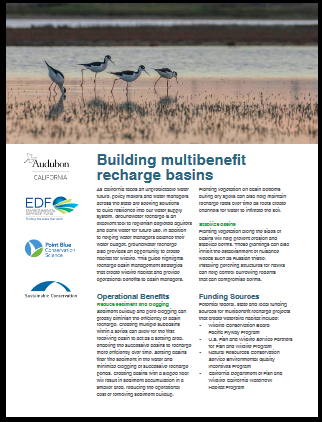 As California faces an unpredictable water future, policy makers and water managers across the state are seeking solutions to build resilience into our water supply system. Groundwater recharge is an excellent tool to replenish depleted aquifers and bank water for future use.
As California faces an unpredictable water future, policy makers and water managers across the state are seeking solutions to build resilience into our water supply system. Groundwater recharge is an excellent tool to replenish depleted aquifers and bank water for future use.
In addition to helping water managers balance their water budget, groundwater recharge also provides an opportunity to create habitat for wildlife.
This guide highlights recharge basin management strategies that create wildlife habitat and provide operational benefits to basin managers
Guide to on-farm recharge and waterbird habitat
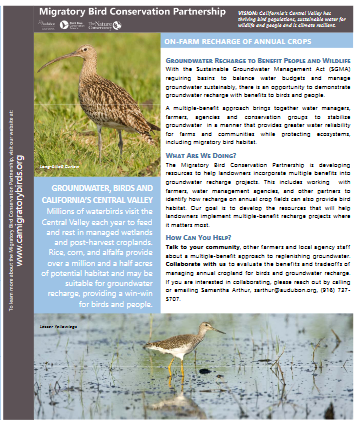 With the Sustainable Groundwater Management Act (SGMA) requiring basins to balance water budgets and manage groundwater sustainably, there is an opportunity to demonstrate groundwater recharge with benefits to birds and people.
With the Sustainable Groundwater Management Act (SGMA) requiring basins to balance water budgets and manage groundwater sustainably, there is an opportunity to demonstrate groundwater recharge with benefits to birds and people.
A multiple-benefit approach brings together water managers, farmers, agencies and conservation groups to stabilize groundwater in a manner that provides greater water reliability for farms and communities while protecting ecosystems, including migratory bird habitat.
Multi-benefit groundwater recharge case studies
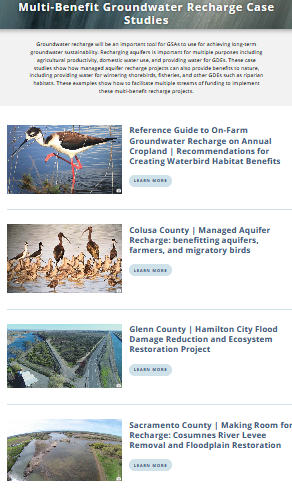 Groundwater recharge will be an important tool for GSAs to use for achieving long-term groundwater sustainability. Recharging aquifers is important for multiple purposes including agricultural productivity, domestic water use, and providing water for GDEs.
Groundwater recharge will be an important tool for GSAs to use for achieving long-term groundwater sustainability. Recharging aquifers is important for multiple purposes including agricultural productivity, domestic water use, and providing water for GDEs.
These case studies show how managed aquifer recharge projects can also provide benefits to nature, including providing water for wintering shorebirds, fisheries, and other GDEs such as riparian habitats. These examples show how to facilitate multiple streams of funding to implement these multi-benefit recharge projects.
Multi-Benefit Groundwater Recharge Case Studies
Water Available for Replenishment Report
A critical element of sustainable groundwater management is the replenishment of groundwater basins. SGMA directs the California Department of Water Resources (DWR) to provide assistance to local agencies in estimating the amount of water available for groundwater replenishment. The act directs DWR to prepare a report “that presents the department’s best estimate, based on available information, of water available for replenishment of groundwater in the state” (California Water Code Section 10729(c)).
DWR has developed planning estimates of surface water available for replenishment (referred to in this report as WAFR estimates) for each of the state’s 10 hydrologic regions and 56 planning areas. These estimates and the related water resources information are presented in this report.
Managed Aquifer Recharge (MAR)
Managed aquifer recharge (MAR), also known as water banking, consists of water management methods that recharge an aquifer using either surface or underground recharge techniques. The stored water is available for use in dry years when surface water supplies may be low.
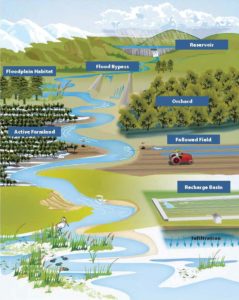 Flood-Managed Aquifer Recharge (Flood-MAR)
Flood-Managed Aquifer Recharge (Flood-MAR)
“Flood-MAR” is an integrated and voluntary resource management strategy that uses flood water resulting from, or in anticipation of, rainfall or snow melt for managed aquifer recharge (MAR) on agricultural lands and working landscapes, including but not limited to refuges, floodplains, and flood bypasses.
Flood-MAR can be implemented at multiple scales, from individual landowners diverting flood water with existing infrastructure, to using extensive detention/recharge areas and modernizing flood management infrastructure/operations.
Learn more about Flood-MAR at the DWR webpage.
Groundwater Recharge Assessment Tool (GRAT)
 Sustainable Conservation’s Groundwater Recharge Assessment Tool (GRAT) provides irrigation districts and GSAs with a decision support tool that will enable them to easily create and assess recharge scenarios. ]
Sustainable Conservation’s Groundwater Recharge Assessment Tool (GRAT) provides irrigation districts and GSAs with a decision support tool that will enable them to easily create and assess recharge scenarios. ]
The GRAT tool enables water managers to evaluate where (active cropland, fallow land, and dedicated recharge basins), when (which weeks across multiple water year types, across a 20-year planning horizon) and how much water will be recharged based on best available data and hydrologic, agronomic and geologic science. It enables GSA’s to see their most cost-effective options and consider the unintended environmental and social impacts in their basins.
Recharge Net Metering
A key challenge for developing distributed groundwater recharge projects lies in creating incentives that will motivate landowners, tenants, and other stakeholders to participate. Recharge Net Metering (ReNeM) is a strategy derived from a renewable energy incentive known as Net Energy Metering which encourages the adoption of rooftop solar panels.
Groundwater Recharge and Water Quality
Groundwater recharge by natural or artificial means can cause changes in groundwater quality. These changes will depend on many factors, including the chemistry of the source water, land use, soil and sediment characteristics, the groundwater flow dynamics. The potential for water-quality changes should be evaluated before, during, and after implementation of an artificial recharge program.
Water rights and permit information
Depending upon the parameters of the recharge project, you may or may not need to obtain a water right or other permit from the State Water Board. Generally, capturing and storing surface water generally requires an appropriative water right. Parties can obtain new water rights or change existing water rights to authorize groundwater recharge projects.
For parties obtaining new water rights, there are different water right applications that are available for groundwater recharge: standard and temporary. The type of application needed depends on the project operation length, intended use, and urgency.
Standard water rights are ideal for long term projects. Temporary permits are best for short term diversions. However, temporary permits are not water rights, but rather they are a conditional approval to divert and use available water that has not been claimed by a water right holder.
Click here for the groundwater recharge permitting page at the State Water Board.
Protection of Groundwater Recharge Areas
Recharge areas are those areas that provide the primary means of replenishing groundwater. Good natural recharge areas are those where good quality surface water is able to percolate through the sediments and rocks to the saturated zone which contains groundwater. If recharge areas cease to function properly, it will limit groundwater replenishment and/or groundwater quality for storage or use.
Protection of recharge areas requires a number of actions based on two primary goals: (1) ensuring that areas suitable for recharge continue to be capable of adequate recharge rather than being covered by urban infrastructure, such as buildings and roads, and (2) preventing pollutants from entering groundwater to avoid expensive treatment that may be necessary prior to beneficial use.
——-
Groundwater recharge articles at Maven’s Notebook
- Notebook groundwater recharge posts

Explore groundwater recharge at the California Water Library
——-
{{ document.post_title }}
{{ document.publisher }} | {{ document.document_date }}
{{ document.post_content_short }}



